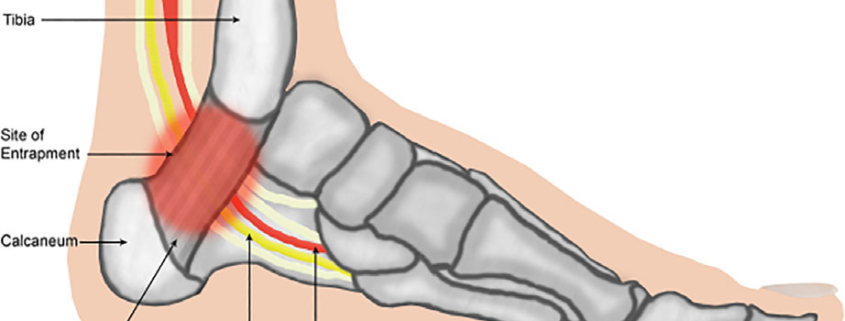Tarsal Tunnel Syndrome

Overview
Tarsal Tunnel Syndrome (TTS) is a common but often misunderstood condition that affects the nerves in the feet and ankle. It’s similar to Carpal Tunnel Syndrome, which affects the hand and wrist, but occurs in the tarsal tunnel, a narrow space inside your ankle. When the posterior tibial nerve, which runs through this tunnel, is compressed or damaged, it can lead to TTS, causing pain and discomfort in the affected area. Understanding this condition can help you manage its symptoms more effectively and ensure better foot health.
Types
While TTS is a specific condition, it is also part of a broader group of problems known as Peripheral Neuropathies, in which nerves outside the brain and spinal cord become compressed or damaged. Another closely related condition to TTS is Plantar Fasciitis, which is an inflammation of the fibrous tissue (plantar fascia) along the bottom of your foot.
Causes
TTS can be caused by anything that compresses or puts pressure on the posterior tibial nerve. These include:
-
- Injuries such as fractures or sprains
-
- Ganglion cysts
-
- Varicose veins in the tarsal tunnel
-
- Abnormal structures like bone spurs
-
- Flat feet
-
- Systemic diseases like diabetes or arthritis
Symptoms
Symptoms of TTS are typically experienced on the inside of the ankle or the bottom of the foot. They can include:
-
- Tingling or burning sensations, often described as “pins and needles”
-
- Pain, including shooting pain
-
- Numbness
-
- Swelling
-
- Weakness and foot fatigue
Diagnosis
Diagnosing TTS typically involves a combination of physical examinations, patient history, and tests. A healthcare provider will examine your foot for physical signs of TTS, such as swelling or tenderness. They may also perform a Tinel’s test, where the nerve is lightly tapped to see if it causes tingling or pain. X-rays, ultrasound or advanced imaging like MRI can help rule out other conditions.
Treatment Options
The treatment for TTS can vary depending on the severity of the condition. Some possible treatments include:
-
- Physical therapy or exercises to strengthen and stretch the muscles
-
- Orthotic devices or shoe modifications to correct or support foot posture
-
- Medications such as nonsteroidal anti-inflammatory drugs (NSAIDs) to reduce inflammation and pain
-
- Injections of corticosteroids to reduce inflammation around the nerve
-
- Rarely, surgical intervention to relieve pressure on the nerve
Living With Tarsal Tunnel Syndrome
Living with TTS involves certain lifestyle changes that can help manage the condition. These include:
-
- Rest and elevate your feet regularly, especially after long periods of standing or walking.
-
- Maintain a healthy weight to reduce stress on your feet.
-
- Use proper footwear that provides support and comfort.
-
- Regular gentle exercise to promote circulation and nerve health in the area.
-
- Pace yourself during activities to avoid overusing your feet and ankles.
-
- Medication management, if prescribed by a healthcare professional.
When to Seek Help
While some cases of TTS can be treated effectively with lifestyle changes and over-the-counter treatments, it’s crucial to seek medical attention when:
-
- Pain or discomfort in the foot or ankle persists despite home treatment
-
- There is noticeable change in foot shape or structure
-
- There’s loss of function or severe weakness in the foot
-
- You experience persistent numbness or loss of sensation, which may indicate more serious nerve damage
Understanding and effectively managing Tarsal Tunnel Syndrome is essential for maintaining your quality of life. With awareness comes the power to seek the right treatment and to adapt your lifestyle accordingly.
